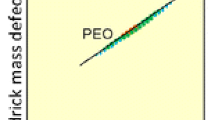Abstract
The investigation and analysis of polymer thin films with Bi n +, n = 1–7 cluster ions has been demonstrated by means of static secondary ion mass spectrometry (SIMS). The highly specific signal enhancement of these primary ions combined with the individual fragmentation pattern of poly(4-vinylphenol) and poly(methyl methacrylate) is the basic principle for a modified approach of data reduction derived from the well-established g-SIMS procedure. Based on mass spectra, which correspond to different cluster ion sizes, not only a clear distinction between the two polymers is feasible but also a further simplification of the data can be demonstrated. It has been successfully proven that characteristic polymer-relevant species can be refined out of the large amount of unspecific and highly fragmented secondary ions, which are usually present in SIMS spectra. Therefore, a more precise and direct interpretation of complex organic fragments becomes feasible, which consequently enables the investigation of even more sophisticated samples.





Similar content being viewed by others
References
Takahashi H, Emoto K, Dubey M, Castner DG, Grainger DW (2008) Adv Funct Mater 18:2079–2088
Lee CY, Harbers GM, Grainger DW, Gamble LJ, Castner DG (2007) J Am Chem Soc 129:9429–9438
Nygren H, Malmberg P (2007) Trends Biotechnol 25:499–504
Pore V, Ritala M, Leskelä M, Areva S, Järn M, Järnström J (2007) J Mater Chem 17:1361–1371
Delcorte A, Yunus S, Wehbe N, Nieuwjaer N, Poleunis C, Felten A, Houssiau L, Pireaux JJ, Bertrand P (2007) Anal Chem 79:3673–3689
Philipp P, Wirtz T, Migeon HN, Scherrer H (2006) Int J Mass Spectrom 253:71–78
Philipp P, Wirtz T, Migeon HN, Scherrer H (2006) Appl Surf Sci 252:7205–7207
Nagy G, Walker AV (2007) Int J Mass Spectrom 262:144–153
De Mondt R, Vaeck L, Heile A, Arlinghaus HF, Nieuwjaer N, Delcorte A, Bertrand P, Lenaerts J, Vangaever F (2008) Rapid Commun Mass Spectrom 22:1481–1496
Kollmer F (2004) Appl Surf Sci 231–232:153–158
Heile A, Lipinsky D, Wehbe N, Delcorte A, Bertrand P, Felten A, Houssiau L, Pireaux JJ, De Mondt R, Van Royen P, Van Vaeck L, Arlinghaus HF (2008) Surf Interface Anal 40:538–542
Nagy G, Lu P, Walker AV (2008) J Am Soc Mass Spectrom 19:33–45
Touboul D, Kollmer F, Niehuis E, Brunelle A, Laprévote O (2005) J Am Soc Mass Spectrom 16:1608–1618
Seah MP (2007) Surf Interface Anal 39:890–897
Seah MP (2007) Surf Interface Anal 39:634–643
Gilmore IS, Seah MP (2000) Appl Surf Sci 161:465–480
Shard AG, Gilmore IS (2008) Int J Mass Spectrom 269:85–94
Green FM, Dell EJ, Gilmore IS, Seah MP (2008) Int J Mass Spectrom 272:38–47
Green FM, Kollmer F, Niehuis E, Gilmore IS, Seah MP (2008) Rapid Commun Mass Spectrom 22:2602–2608
Stephan T, Zehnpfenning J, Benninghoven A (1994) J Vac Sci Technol A 12:405–410
Shard AG, Gilmore IS (2008) Int J Mass Spectrom 269:85–94
Acknowledgement
This work is part of the Christian Doppler Laboratory for Surface and Interface Analysis with ToF-SIMS in cooperation with AT&S Austria Technologie & Systemtechnik AG. The authors are grateful to Stephan Abermann and the Institute for Solid State Electronics, Vienna University of Technology for the helpful estimation of the polymer layer thickness.
Author information
Authors and Affiliations
Corresponding author
Rights and permissions
About this article
Cite this article
Straif, C.J., Hutter, H. Investigation of polymer thin films by use of Bi-cluster-ion-supported time of flight secondary ion mass spectrometry. Anal Bioanal Chem 393, 1889–1898 (2009). https://doi.org/10.1007/s00216-009-2624-0
Received:
Revised:
Accepted:
Published:
Issue Date:
DOI: https://doi.org/10.1007/s00216-009-2624-0




